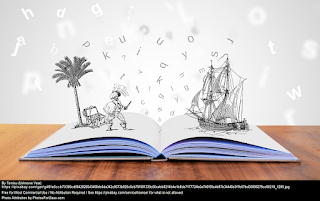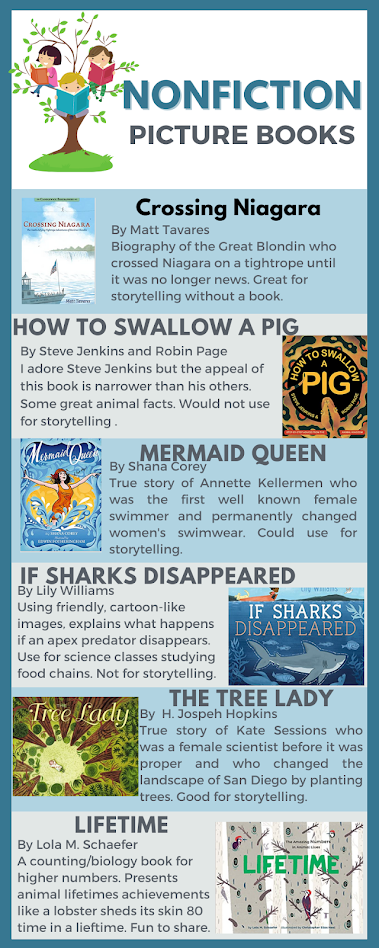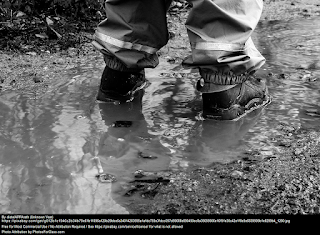Wells_Laura _Reading Reflection
Let's talk about storytelling. I want to start off by saying storytelling is new me. I am not a part of a culture that uses storytelling (just finished the YA book Firekeeper's Daughter which is in part about Native American storytelling....definitely recommend). And I don't recall being exposed to storytellers at a library, just read alouds. So this is all very new to me.
From our textbook
This week we read chapters 1-6 in Storytelling: Art and Technique by Ellin Greene
and Janice Del Negro. Chapter 1 detailed histories of some famous storytellers, and what stood out to me was Shedlock's description of how carefully she chose storytellers: "Poor storytelling is more disastrous than poor story-writing" (p. 14). It would seem that, like teaching, there are some people who are just natural storytellers. While we can improve our storytelling skills, I wonder how many of us will be naturals? In Chapter 2, I was delighted to read about Thorne-Thompson's belief that decoding words does not equate to reading unless a child is able to picture what the words are saying (p. 23). In Chapter 3, I was fascinated that early exposure to stories in preschool improves early math skills by developing logic and analytical skills (p. 49).
Articles and Websites
My background is as a secondary reading and English teacher. I am fascinated by the process of learning to read. Two articles stood out to me this week. "The Early Catastrophe" by Hart and Risley presents solid evidence that the socioeconomic level of parents is strongly connected to the amount of language a child is exposed to and the effects on reading outcomes last far into the child's future (2003). It was horrifying to see actual evidence of what I suspected might be true. So the
next question is what can we do about it? I don't think a definitive answer has been found, but I wonder if sharing stories is a nonthreatening way to share a love of words. Perhaps hearing stories eventually develops a love of reading as students experience how a story can make us leave our current space and be transported into the story. Maybe, if kids struggle to read due to lack of word exposure, good storytelling can create positive story experiences. I mean, how many times has the story of a lost kid discovering a library been told??
As a future school librarian, two questions keep running through my mind.
1) What is the role of storytelling, separate from a read aloud, in the school setting?2) Is the effectiveness of storytelling, in its most natural from, that is without props or multimedia, different for the current generation?
I found some answers to my first question, but not my second. Venkat (2020) writes about ideas for using storytelling along with the printed book. She suggests telling a story before seeing the printed books with pictures. This gives kids a chance to use their imagination and then compare it with the what the illustrator saw. I like deeper engagement of this use of storytelling. Cherry (2017) offered some ideas of how he used stories in a history classroom. As a school librarian and a history teacher, he did not have the struggle that is sometimes collaboration, and the storytellers were the kids, not the teachers. Or they were the kids capturing the stories of adults. I do believe, though I don't have evidence, that stories stick in minds longer than facts, I can see how having the kids gather enough information about an explorer and then share a story about being that explorer might be more powerful than just textbook information. I still am uncertain if there is more power in a read aloud (with pictures) than a story telling (especially if I don't end up being a skilled one). Which one is more beneficial for literacy development?
Of course a part of me thinks that storytelling is just enjoyable and it's literary development does not matter as it immerses a student in a rich history they need to experience.
Picture Books
This week we read picture books, fairy tales, and fables. As a teacher, I am most familiar with picture books as a source of a read aloud. I let myself just browse the children's section of my public library. I chose books by authors I thought might appeal to kids or who had appealed to me in the past. As a source for storytelling, I only found one book that I could imagine using for storytelling. Modern picture books, with their dependence on images, felt hard to use for storytelling. Pirate Stew had the most potential as a story to tell because of rhyme and repetition and the appeal of parents turning into pirates. Plus who can resist pirate noises and pirate jokes! I am not sure I have a great pirate voice though. The YouTube link below is to a video of Gaiman, the author, reading the first 1/3 of the story. He is wonderful and draws you into the story perfectly. He ends with a chant that is repeated throughout the book. I think young kids would love a good telling of this tale.
I did notice that in our textbook, most of the discussion about storytelling selection excluded modern picture book titles and focused more on legends and fairy tales and fables. Perhaps because these stories are part of a heritage or perhaps because often the tellings of these tales are not picture-dependent?
Fairy Tales
I would not use these stories or even read them aloud. I did love Goldilocks and Just One Bear in which a bear visits an apartment in a busy downtown and does variations of all that Goldilocks did only to discover this apartment belongs to grownup Goldilocks and her family. I can imagine using this story as a storyteller. Plus it was told with delightful alliteration and onomatopoeia. Rapunzel by Chloe Perkins was an adaption by an Indian writer with an Indian illustrator. It was a simple board book. It was a beautiful edition that I might read aloud but not inspiring for storytelling. Really, the best potential for a storyteller was Frog Prince by Brother's Grimm found in the Random House Book of Fairy Tales. As a storyteller, this collection had the most appeal because of the detail in the stories through the words. I am most intrigued by classic fairy tales as a storyteller. It would be interesting to know which grade level in my state assigns fairy tales as part of the curriculum.
Sources
Cherry, W.J. (2017 November/December). Our place in the universe: The importance of story and storytelling in the classroom. Knowledge Quest, 46 (2).
Greene, E. & Del Negro, J.M. (2010). Storytelling: Art and technique (4th ed.). Libraries Unlimited.
Hart, B. & Risley, T. (2003, Spring). The early catastrophe: The 30 million word gap by age 3. American Educator.
Venkat, S. (2020, May/June). Using oral storytelling techniques in reading sessions. Knowledge Quest, 48 (5), 54-56.



.png)
.png)





As an early childhood teacher, I was first drawn to your list of picture books. I had not heard of Pirate Stew and was intrigued because it reminded me of a book from my childhood, Grandma and the Pirates by Phoebe Gillam. So, I clicked on the video to listen to the story (I didn't pay attention to the pictures from the book) and could not stop watching and connecting it to the book from my childhood. I believe that is the magic that can lie within a storytelling experience. One thing can remind a listener of a happy memory or bring about a pleasant thought; from there, the listener is hooked. Without thinking, I integrated a literacy skill into the experience, comparing and contrasting the stories, one in which I listened to an excerpt and glimpsed a few pictures and one I could probably recite for you right now due to the number of times my mother read it as a child.
ReplyDeleteThat led me to reflect on your question about whether storytelling or read-aloud experiences are more beneficial for literacy development? I do not believe that either is more valuable than the other holistically. Educators should use them both to help introduce, teach, and review a literacy skill to highlight different literature formats and allow students to see that books are not the only pieces of literature that contain a particular skill. Depending on the skill you teach, one might out way the other for the best method, but the other could still be used also.
Hi Laura,
ReplyDeleteThis post is very thought provoking. I enjoyed reading about your thoughts throughout your readings. As a middle school ELA teacher, I can relate to your background in secondary reading and English. Your line of thinking about how sharing stories can help create positive experiences that might translate to students developing a love of reading sounds promising to me. This idea relates back to how early exposure to stories can improve early math skills (Greene & Del Negro, 2010). Maybe if teachers use this knowledge and tell plenty of stories, then this may help students have different reading outcomes.
Before reading your post, I had not heard of Goldilocks and Just One Bear. It seems like it would be perfect for storytelling since it utilizes alliteration and onomatopoeia, which seem like great literary devices to captivate an audience. Also, I found it interesting that some of the fairy tales you read were told with a twist, such as Goldilocks and Just One Bear and Interstellar Cinderella. It might be an interesting idea to test out which types of fairytales audiences would like to listen to more. Personally, I agree with you about the older audiences being better suited for fractured fairytales since they are already familiar with the original story.
Laura,
ReplyDeleteI really enjoyed the set up of your blog, it's very easy to follow while reading and has great flow. I really enjoyed how you posed some questions you had, I didnt even think about doing that with some questions I have asked myself. I really really enjoy your mini book lists! How did you make those lists, I would love to know. I enjoyed seeing what books you read for this week. I have read some fables and fairy tales from other countries, but the Chinese Fables book you mentioned is new to me. I love reading Three Ninja Pigs to little kids, I always try to read the "original" verion too and it is fun to compare them. Goldilocks and Just One Bear seems like a great twist on the fairy tale and a cute book to boot. I saw that you mentioned that you wondered what grade your state assigns fairy tales. What state do you live in? As a fourth grade teacher it has been a topic for us at the very end of the school year if we have the time after state testing (SC).
-Megan